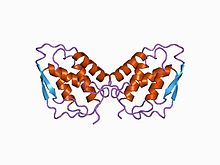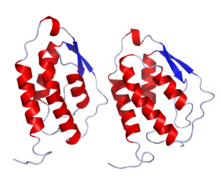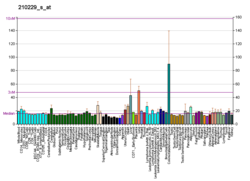Granulocyte-macrophage_colony-stimulating_factor
Granulocyte-macrophage colony-stimulating factor
Mammalian protein found in Homo sapiens
Granulocyte-macrophage colony-stimulating factor (GM-CSF), also known as colony-stimulating factor 2 (CSF2), is a monomeric glycoprotein secreted by macrophages, T cells, mast cells, natural killer cells, endothelial cells and fibroblasts that functions as a cytokine. The pharmaceutical analogs of naturally occurring GM-CSF are called sargramostim and molgramostim.
| Granulocyte-macrophage colony-stimulating factor | |||||||||
|---|---|---|---|---|---|---|---|---|---|
 three-dimensional structure of recombinant human granulocyte-macrophage colony-stimulating factor (rhGM_CSF) | |||||||||
| Identifiers | |||||||||
| Symbol | GM_CSF | ||||||||
| Pfam | PF01109 | ||||||||
| Pfam clan | CL0053 | ||||||||
| InterPro | IPR000773 | ||||||||
| PROSITE | PDOC00584 | ||||||||
| SCOP2 | 2gmf / SCOPe / SUPFAM | ||||||||
| |||||||||
 | |
| Clinical data | |
|---|---|
| ATC code | |
| Identifiers | |
| |
| CAS Number | |
| DrugBank |
|
| ChemSpider |
|
| Chemical and physical data | |
| Formula | C639H1006N168O196S8 |
| Molar mass | 14434.54 g·mol−1 |
| | |
Unlike granulocyte colony-stimulating factor, which specifically promotes neutrophil proliferation and maturation, GM-CSF affects more cell types, especially macrophages and eosinophils.[5]
GM-CSF is a monomeric glycoprotein that functions as a cytokine—it is a white blood cell growth factor.[6] GM-CSF stimulates stem cells to produce granulocytes (neutrophils, eosinophils, and basophils) and monocytes. Monocytes exit the circulation and migrate into tissue, whereupon they mature into macrophages and dendritic cells. Thus, it is part of the immune/inflammatory cascade, by which activation of a small number of macrophages can rapidly lead to an increase in their numbers, a process crucial for fighting infection.[citation needed]
GM-CSF also has some effects on mature cells of the immune system. These include, for example, enhancing neutrophil migration and causing an alteration of the receptors expressed on the cells surface.[7]
GM-CSF signals via signal transducer and activator of transcription, STAT5.[8] In macrophages, it has also been shown to signal via STAT3. The cytokine activates macrophages to inhibit fungal survival. It induces deprivation in intracellular free zinc and increases production of reactive oxygen species that culminate in fungal zinc starvation and toxicity.[9] Thus, GM-CSF facilitates development of the immune system and promotes defense against infections.[citation needed]
GM-CSF also plays a role in embryonic development by functioning as an embryokine produced by reproductive tract.[10]
The human gene has been localized in close proximity to the interleukin 3 gene within a T helper type 2-associated cytokine gene cluster at chromosome region 5q31, which is known to be associated with interstitial deletions in the 5q- syndrome and acute myelogenous leukemia. GM-CSF and IL-3 are separated by an insulator element and thus independently regulated.[11] Other genes in the cluster include those encoding interleukins 4, 5, and 13.[12]
Human granulocyte-macrophage colony-stimulating factor is glycosylated in its mature form.[citation needed]
GM-CSF was first cloned in 1985, and soon afterwards three potential drug products were being made using recombinant DNA technology: molgramostim was made in Escherichia coli and is not glycosylated, sargramostim was made in yeast, has a leucine instead of proline at position 23 and is somewhat glycosylated, and regramostim was made in Chinese hamster ovary cells (CHO) and has more glycosylation than sargramostim. The amount of glycosylation affects how the body interacts with the drug and how the drug interacts with the body.[13]
At that time, Genetics Institute, Inc. was working on molgramostim,[14] Immunex was working on sargramostim (Leukine),[15] and Sandoz was working on regramostim.[16]
Molgramostim was eventually co-developed and co-marketed by Novartis and Schering-Plough under the trade name Leucomax for use in helping white blood cell levels recover following chemotherapy, and in 2002 Novartis sold its rights to Schering-Plough.[17][18]
Sargramostim was approved by the US FDA in 1991 to accelerate white blood cell recovery following autologous bone marrow transplantation under the trade name Leukine, and passed through several hands, ending up with Genzyme,[19] which was subsequently acquired by Sanofi. Leukine is now owned by Partner Therapeutics (PTx).
Imlygic was approved by the US FDA in October 2015,[20] and in December 2015 by the EMA, as an oncolytic virotherapy, commercialized by Amgen Inc. This oncolytic herpes virus, named Talimogene laherparepvec, has been genetically engineered to express human GM-CSF using the tumor cells machinery.[21]
GM-CSF is found in high levels in joints with rheumatoid arthritis and blocking GM-CSF as a biological target may reduce the inflammation or damage. Some drugs (e.g. otilimab) are being developed to block GM-CSF.[22] In critically ill patients GM-CSF has been trialled as a therapy for the immunosuppression of critical illness, and has shown promise restoring monocyte[23] and neutrophil[24] function, although the impact on patient outcomes is currently unclear and awaits larger studies.
GM-CSF stimulates monocytes and macrophages to produce pro-inflammatory cytokines, including CCL17.[25] Elevated GM-CSF has been shown to contribute to inflammation in inflammatory arthritis, osteoarthritis, colitis asthma, obesity, and COVID-19.[25][26][27]
Monoclonal antibodies against GM-CSF are being used as treatment in clinical trials against rheumatoid arthritis, ankylosing spondylitis, and COVID-19.[25]
- CFU-GM
- Filgrastim (Neupogen, a granulocyte colony-stimulating factor (G-CSF) analog)
- Granulocyte-macrophage colony-stimulating factor receptor
- Lenzilumab
- Pegfilgrastim (Neulasta, a PEGylated form filgrastim)
- "Human PubMed Reference:". National Center for Biotechnology Information, U.S. National Library of Medicine.
- "Mouse PubMed Reference:". National Center for Biotechnology Information, U.S. National Library of Medicine.
- Root RK, Dale DC (March 1999). "Granulocyte colony-stimulating factor and granulocyte-macrophage colony-stimulating factor: comparisons and potential for use in the treatment of infections in nonneutropenic patients". The Journal of Infectious Diseases. 179 (Suppl 2): S342-52. doi:10.1086/513857. PMID 10081506.
- Francisco-Cruz A, Aguilar-Santelises M, Ramos-Espinosa O, Mata-Espinosa D, Marquina-Castillo B, Barrios-Payan J, Hernandez-Pando R (January 2014). "Granulocyte-macrophage colony-stimulating factor: not just another haematopoietic growth factor". Medical Oncology. 31 (1): 774. doi:10.1007/s12032-013-0774-6. PMID 24264600. S2CID 24452892.
- Gasson JC (March 1991). "Molecular physiology of granulocyte-macrophage colony-stimulating factor". Blood. 77 (6): 1131–45. doi:10.1182/blood.V77.6.1131.1131. PMID 2001448.
- Voehringer D (October 2012). "Basophil modulation by cytokine instruction". European Journal of Immunology. 42 (10): 2544–50. doi:10.1002/eji.201142318. PMID 23042651. S2CID 23972211.
- Subramanian Vignesh K, Landero Figueroa JA, Porollo A, Caruso JA, Deepe GS (October 2013). "Granulocyte macrophage-colony stimulating factor induced Zn sequestration enhances macrophage superoxide and limits intracellular pathogen survival". Immunity. 39 (4): 697–710. doi:10.1016/j.immuni.2013.09.006. PMC 3841917. PMID 24138881.
- Hansen PJ, Dobbs KB, Denicol AC (September 2014). "Programming of the preimplantation embryo by the embryokine colony stimulating factor 2". Animal Reproduction Science. 149 (1–2): 59–66. doi:10.1016/j.anireprosci.2014.05.017. PMID 24954585.
- Bowers SR, Mirabella F, Calero-Nieto FJ, Valeaux S, Hadjur S, Baxter EW, et al. (April 2009). "A conserved insulator that recruits CTCF and cohesin exists between the closely related but divergently regulated interleukin-3 and granulocyte-macrophage colony-stimulating factor genes". Molecular and Cellular Biology. 29 (7): 1682–93. doi:10.1128/MCB.01411-08. PMC 2655614. PMID 19158269.
- Armitage JO (December 1998). "Emerging applications of recombinant human granulocyte-macrophage colony-stimulating factor" (PDF). Blood. 92 (12): 4491–508. doi:10.1182/blood.V92.12.4491. PMID 9845514.
- "Molgramostim". AdisInsight. Retrieved 3 April 2018.
- Staff (May 2008). "Back to the Future: Original Liquid Leukine® Coming Soon" (PDF). Oncology Business Review. Archived from the original (PDF) on 2016-08-25. Retrieved 2016-08-29.
- Hussein AM, Ross M, Vredenburgh J, Meisenberg B, Hars V, Gilbert C, et al. (November 1995). "Effects of granulocyte-macrophage colony stimulating factor produced in Chinese hamster ovary cells (regramostim), Escherichia coli (molgramostim) and yeast (sargramostim) on priming peripheral blood progenitor cells for use with autologous bone marrow after high-dose chemotherapy". European Journal of Haematology. 55 (5): 348–56. doi:10.1111/j.1600-0609.1995.tb00713.x. PMID 7493686. S2CID 25424116.
- "Press release: Novartis Oncology sharpens focus on key growth drivers". Novartis via SEC Edgar. 30 October 2002.
- "Scientific Conclusions and Grounds for Amendment of the Summary of Product Characteristics Presented by the EMEA" (PDF). EMA CPMP. 27 June 2000.
- "Bayer Healthcare Pharmaceuticals Plant, Snohomish County, Washington State". pharmaceutical-technology.com. Retrieved 12 November 2011.
- U.S. Food & Drug Administration. "IMLYGIC (talimogene laherparepvec)". fda.gov. Retrieved 17 December 2019.
- Andtbacka RH, Kaufman HL, Collichio F, Amatruda T, Senzer N, Chesney J, et al. (September 2015). "Talimogene Laherparepvec Improves Durable Response Rate in Patients With Advanced Melanoma". Journal of Clinical Oncology. 33 (25): 2780–8. doi:10.1200/JCO.2014.58.3377. PMID 26014293.
- Meisel C, Schefold JC, Pschowski R, Baumann T, Hetzger K, Gregor J, et al. (October 2009). "Granulocyte-macrophage colony-stimulating factor to reverse sepsis-associated immunosuppression: a double-blind, randomized, placebo-controlled multicenter trial". American Journal of Respiratory and Critical Care Medicine. 180 (7): 640–8. doi:10.1164/rccm.200903-0363OC. PMID 19590022.
- Pinder EM, Rostron AJ, Hellyer TP, Ruchaud-Sparagano MH, Scott J, Macfarlane JG, et al. (October 2018). "Randomised controlled trial of GM-CSF in critically ill patients with impaired neutrophil phagocytosis". Thorax. 73 (10): 918–925. doi:10.1136/thoraxjnl-2017-211323. PMC 6166597. PMID 30064991.
- Lee KM, Achuthan AA, Hamilton JA (2020). "GM-CSF: A Promising Target in Inflammation and Autoimmunity". ImmunoTargets and Therapy. 9: 225–240. doi:10.2147/ITT.S262566. PMC 7605919. PMID 33150139.
- Thwaites RS, Sanchez Sevilla Uruchurtu A, Siggins MK, Liew F, Russell CD, Moore SC, et al. (March 2021). "Inflammatory profiles across the spectrum of disease reveal a distinct role for GM-CSF in severe COVID-19". Science Immunology. 6 (57): eabg9873. doi:10.1126/sciimmunol.abg9873. PMC 8128298. PMID 33692097.
- Zhao Y, Kilian C, Turner JE, Bosurgi L, Roedl K, Bartsch P, et al. (February 2021). "Clonal expansion and activation of tissue-resident memory-like Th17 cells expressing GM-CSF in the lungs of severe COVID-19 patients". Science Immunology. 6 (56). doi:10.1126/sciimmunol.abf6692. PMC 8128299. PMID 33622974.
- Official gentaur web site
- Official Leukine web site
- Granulocyte-Macrophage+Colony-Stimulating+Factor at the U.S. National Library of Medicine Medical Subject Headings (MeSH)
- Overview of all the structural information available in the PDB for UniProt: P04141 (Granulocyte-macrophage colony-stimulating factor) at the PDBe-KB.





